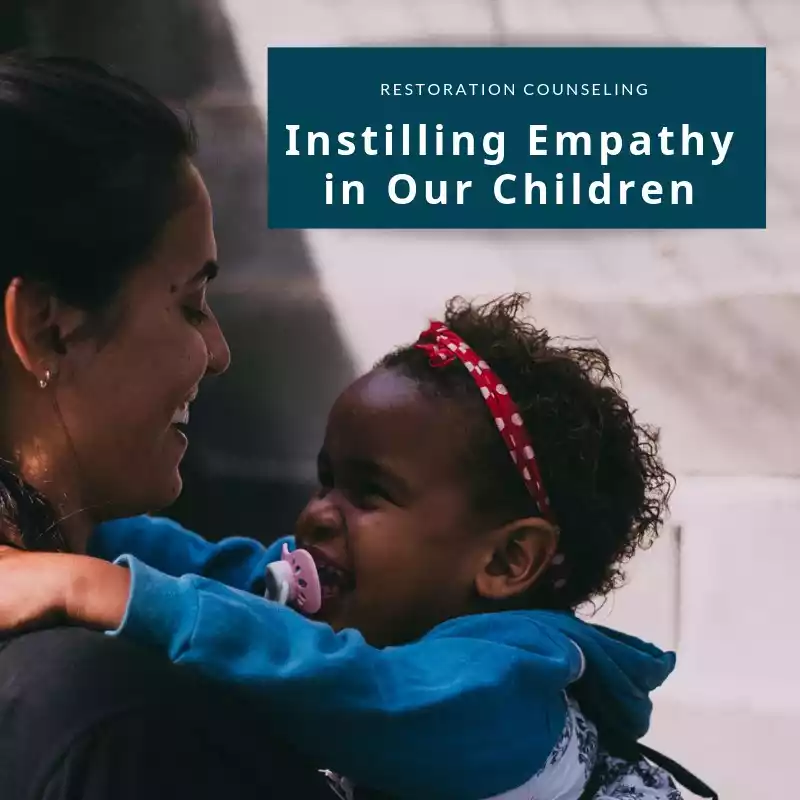
Instilling Empathy in Our Children
Take a moment and think about a shift in your life. What transpired within that context to help you change the trajectory in which you were headed? Was it when someone blasted you with a lecture and reminders of ways you’ve fallen short? Was it when someone confronted you on your inward motives? If I were to guess, I bet it was a time where you felt genuinely cared for and out of that care you were able to hear the truth of their concern.
When it comes down to it, we want to feel understood and met before anyone tries to fix our situation or hurts. There is value in being heard and there’s value in being still and enduring someone’s grief, fear or even joy. If we as adults can relate to the need of feeling heard, how much more do our children share that same innate need?
What we are referring to is empathy. Empathy is defined as the ability to understand and share the feelings of another. A friendly way to think of empathy is putting ourselves in someone else’s shoes.
Empathy indeed is a characteristic that is advantageous to possess. So how do we go about teaching our kids to see a situation from someone else’s perspective? First and foremost, our children learn empathy within the context of relationship. It is not something they can learn in a book, but rather it is through our interactions as we parent. Here are two ways in which we can model empathy to our children.
1. Caring, nonverbal communication.
When your child’s feelings are big, get down on their level, hold their hands gently and make eye contact. There is great power in your presence and the ability to sit close as your child emotes. It is the first step in helping your child feel heard.
2. Validate your child’s perspective
A helpful tool in validating is stating the feeling behind the content their sharing. For example, your child may approach you angrily and say, “I can’t do my math homework! It’s too hard and confusing. I never get it right, so why even try!” A validating response could be, “It sounds like the homework is really difficult… and it’s frustrating to even think about where to begin.” When we meet our child in their emotion they feel understood and as a result, become disarmed.
Now, we as parents won’t get it right every time. There will be tantrums and rants that only escalate ours and our child’s emotions. In fact, there are two common hindrances that can get in the way of us showing empathy. First, we assume that our child has the ability to think and reason similarly to us. The truth is that our child’s brain is ever developing and doesn’t reach full maturation until around the age of 25. Dr. Barbara Sorrels, a child development expert, reflects upon developmental research from Berkley and states, “that when scientists measure the brain waves of preschoolers, their brain activity looks like that of an adult on a psychedelic drug!” No wonder we struggle with our child’s waves of emotion and lack of reason at times. Their tantrums/meltdowns are the effects of a brain still forming and maturing. Even if their emotions don’t make sense to us, they are very real to our children. Let’s meet our children where they are and use those emotionally laden moments to connect and understand their perspective.
A second hindrance to parents showing their child empathy is the assumption that empathy does not lead to reasonable or logical conclusions. As parents, we want our child to see things rationally and out of this desire we can ignore their feelings entirely. When we choose to ignore, their feelings only escalate. However, showing empathy does not necessarily mean that we agree with our child’s perspective or believe that it’s completely rational. Rather, we first validate their feelings and seek understanding even if we don’t agree. After we connect through validating, then we proceed to speak logically. Take the time to brainstorm solutions to their problem together and watch their reason become activated and their emotions dissipate.
One of the most influential gifts we can give our children is deep, loving care. When a child genuinely feels understood, belief and empowerment develop within our children. Choosing to demonstrate empathy is as if we have a megaphone into their life shouting, “I see you! I hear you! And I’m here for you! Now, go and do amazing things!”
Other interactive ways to teach empathy:
1. Build an emotional vocabulary by playing a feeling game together. Take paper and together write out various feeling words. Cut the words into strips and place the words in a bowl. Choose a feeling word from the bowl and take turns acting or drawing the emotion for the other person to guess.
2. Provide a need for someone around you. Who in your circle may be going through something hard? Sickness, life transitions, a death of a loved one? Include your child and brainstorm ways in which you can meet their needs. Are you planning on bringing a meal to a friend? Let your child write a note to go with it. Watch and see them take ownership and begin to consider the needs of others before their own.
3. Read children’s books on empathy together. The Rabbit Listened by Cori Doerrfeld is an excellent place to begin.


